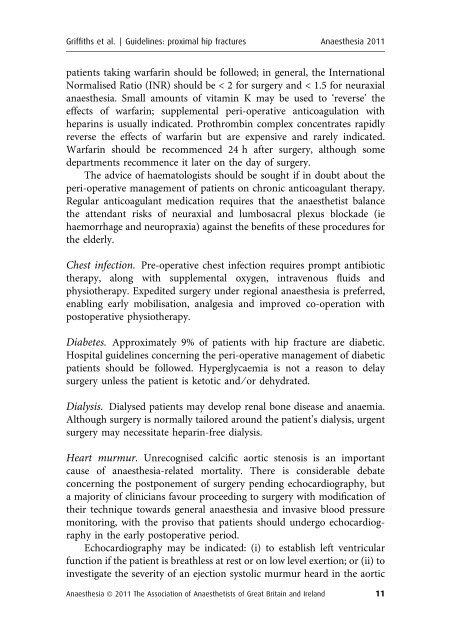Management of Proximal Femoral Fractures 2011 - aagbi
Management of Proximal Femoral Fractures 2011 - aagbi
Management of Proximal Femoral Fractures 2011 - aagbi
You also want an ePaper? Increase the reach of your titles
YUMPU automatically turns print PDFs into web optimized ePapers that Google loves.
Griffiths et al. | Guidelines: proximal hip fractures Anaesthesia <strong>2011</strong>patients taking warfarin should be followed; in general, the InternationalNormalised Ratio (INR) should be < 2 for surgery and < 1.5 for neuraxialanaesthesia. Small amounts <strong>of</strong> vitamin K may be used to ‘reverse’ theeffects <strong>of</strong> warfarin; supplemental peri-operative anticoagulation withheparins is usually indicated. Prothrombin complex concentrates rapidlyreverse the effects <strong>of</strong> warfarin but are expensive and rarely indicated.Warfarin should be recommenced 24 h after surgery, although somedepartments recommence it later on the day <strong>of</strong> surgery.The advice <strong>of</strong> haematologists should be sought if in doubt about theperi-operative management <strong>of</strong> patients on chronic anticoagulant therapy.Regular anticoagulant medication requires that the anaesthetist balancethe attendant risks <strong>of</strong> neuraxial and lumbosacral plexus blockade (iehaemorrhage and neuropraxia) against the benefits <strong>of</strong> these procedures forthe elderly.Chest infection. Pre-operative chest infection requires prompt antibiotictherapy, along with supplemental oxygen, intravenous fluids andphysiotherapy. Expedited surgery under regional anaesthesia is preferred,enabling early mobilisation, analgesia and improved co-operation withpostoperative physiotherapy.Diabetes. Approximately 9% <strong>of</strong> patients with hip fracture are diabetic.Hospital guidelines concerning the peri-operative management <strong>of</strong> diabeticpatients should be followed. Hyperglycaemia is not a reason to delaysurgery unless the patient is ketotic and ⁄ or dehydrated.Dialysis. Dialysed patients may develop renal bone disease and anaemia.Although surgery is normally tailored around the patient’s dialysis, urgentsurgery may necessitate heparin-free dialysis.Heart murmur. Unrecognised calcific aortic stenosis is an importantcause <strong>of</strong> anaesthesia-related mortality. There is considerable debateconcerning the postponement <strong>of</strong> surgery pending echocardiography, buta majority <strong>of</strong> clinicians favour proceeding to surgery with modification <strong>of</strong>their technique towards general anaesthesia and invasive blood pressuremonitoring, with the proviso that patients should undergo echocardiographyin the early postoperative period.Echocardiography may be indicated: (i) to establish left ventricularfunction if the patient is breathless at rest or on low level exertion; or (ii) toinvestigate the severity <strong>of</strong> an ejection systolic murmur heard in the aorticAnaesthesia ª <strong>2011</strong> The Association <strong>of</strong> Anaesthetists <strong>of</strong> Great Britain and Ireland 11
















